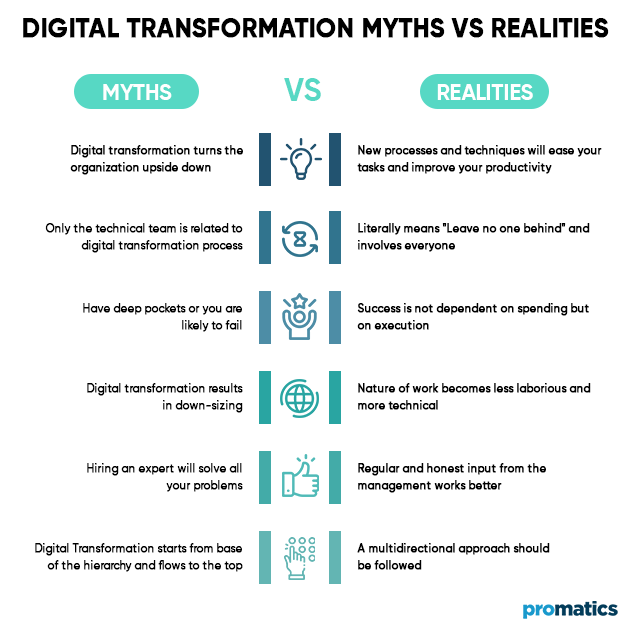Digital Transformation Myths and Realities Explained
We are living in a golden age, where science is moving forwards with leaps and bounds. Technology is advancing at an impeccable rate and our analog world is being digitalized at this very moment. It is important for organizations to keep pace with the development and remain up-to-date with the latest methods and management styles.
The thing is in this world of rapid changes, there are a lot of myths roaming about. Many of these myths are actually misconceptions and absolutely baseless. It is important to be aware of what information is factual and what is a baseless idea that will do nothing apart from hindering your personal and organizational development and growth.
What is Digital Transformation?
Digital transformation means changes made in the strategic, tactical, and operational activities of an organization by accepting and adopting new technologies and methods. Many of these improvements and developments relate to improvements induced by software and machines.
However, these are not limited to mere technical improvements. Agile management styles and decision-making processes such as design sprints also are part of this digital transformation. The primary idea is to contribute towards more efficient and profitable businesses that ‘adds value’ in real terms of the world.
Busting some Myths about Digital transformation
In this era of the internet, when anyone can post anything and communicate it to the masses, it is vital for stakeholders to have factual knowledge. We, being the experts, feel it ass our social responsibility to differentiate between what is correct and what is simply a misconception that should be negated effectively.
Here are some myths that you are very likely to hear when you talk about digital transformation, some existing due to lack of understanding while others are utter nonsense.
1. Digital transformation turns the organization upside down
It is a common conception that digitization of methods and improvement of techniques changes the entire organization to such an extent that it becomes difficult to carry on with the new environment successfully. The digital transformation is drastic and people feel insecure with the new methods.
Reality:
It is vital to understand here that any improvement proposed and implemented as part of a digital transformation process is based on the same principles as the processes before the transformation. It means that your processes before and after, in essence, will remain the same.
If you classified an expenditure as ‘traveling and conveyance’, you will continue to classify it as ‘traveling and conveyance’. Just that instead of previously writing it in some book by hand, you will type it in a computer program and get done with it.
Effectively, as an individual in any organization irrespective of your role, if you know the concepts of doing your tasks, there is nothing for you to worry about. Rather you will discover that the new processes and techniques will ease your tasks and improve your productivity while also enhancing convenience.
2. Only the technical team is related to the digital transformation process
It is often thought that the technical staff who are primarily related to the main business operations of a company are responsible and concerned with the process. To better understand this, consider the example of a firm that offers civil engineering consultancy. The organization decides to undergo digital transformation. There may exist a mindset that only the engineering staff should be concerned with the process and not the support functions such as admin or marketing. Sadly, the approach is incorrect.
Reality:
When implementing any improvements at any level or stage, as a person or as a group, it is crucial that you accept and acknowledge the change with your head, heart, and soul. It means that every part of you as a person and every department and function in your organization should accept the new change and understand it.
Make the motive of the American forces ‘Leave no one behind’ as your objective during the process and only then you will achieve the optimal results. Take input from all departments and functions and incorporate their useful suggestions in your transformation plan.
3. Have deep pockets or you are likely to fail
Digital transformation is often confused as a process that requires a lot of money and resources to be spent before it begins to reap any benefits. In case, you do not spend enough, it is very likely that your money will go to waste without reaping any benefits.
Reality:
In reality, it is not really true. There are different types of digital transformations in the process from strategic to operational and it is not compulsory that each one of them requires the acquisition of new property and equipment. It can merely be subscribing to a new type of service and leaving the old one or it can require that you set up a new plant for manufacturing your product. So, it depending upon the process that you upgrade.
Secondly and more importantly, success and failure have less to do with spending and more to do with how you prepare the plan and implement it. Moving from Excel to new accounting software will not cost much but can fail if your employees are not willing to understand it.
4. Digital transformation results in down-sizing
It is the most common concern of employees that when their company is going to change its operations, they are going to lose their jobs. The company will have more efficient operations using modern technology and will no longer need them. Consequently, it will lose them.
Reality:
In fact, it is the fear of being technically obsolete that makes employees approach the transformation process with such a mindset. They are afraid that their knowledge and skills will no longer be useful and, in the end, the company will kick them out because either fewer individuals are required for the task or it now needs people with a different and more advanced skillset.
While it is only human to be concerned about one’s future, we should also understand that this entire process can not be successful without the cooperation of the workforce. For improving their skills and keeping them up-to-date with the change, special training sessions are included as a mandatory part of the process. The company should be willing to and must invest in its workforce or it is very likely that the plan will fail just because its people were not dealt with appropriately.
Additionally, this should also be kept in mind that a change in the process might no longer need you as a data-entry person but it will still need you to monitor the processing of the data and the reports that it will generate. You task just became less laborious and more technical in nature.
5. Hiring an expert will solve all your problems
Many companies, whether small or large go towards hiring a third-party expert when they are looking forward towards digital transformation in their processes. There is nothing wrong with hiring a third-party expert who has experience in implementing such strategies.
These professionals come with experience from multiple industries and trades and have diverse knowledge about solving different types of problems that you may encounter on your way to institutional evolution. In addition, an organization can make good use of a fresh ideology and thought process, different from the approach of individuals already part of the organization. Their judgment will be unique and based on experiences outside of the organization.
All this is very encouraging; however, management often believes that hiring an expert is enough and by doing so, they have effectively and successfully implemented the transformation process. And that, now the senior management should rest while the experts perform their work and lead the organization to the zeniths of success.
Reality:
When you have spent a handsome amount paying for an expert, even reading is this is going to pain but hear me out. Whenever you are willing to implement a change successfully, the motivation for success should be driven from the inside and not from the outside world. This means that the contribution of people working within the organization is equally valuable as the contribution of an expert.
This should also be understood that any person coming from outside the organization can never have enough information about the company as a person who spends 8 hours a day, 5 days a week in that environment and mindset. So, while the expert has experience in providing creative solutions to a problem, he needs regular and honest input from the management for an accurate understanding of the problem.
6. Digital Transformation starts from the base of the hierarchy and flows to the top
This concept is often misunderstood as ‘make changes at the bottom and its effect will climb up the chain automatically’. All management studies favor inducing changes at the grass-root level instead of trying to implement a change from a throne at the top. But, changes only on the ground floor are just not enough.
Consider an example, a company is trying to make its decision-making process more agile so that it has the capacity to deal with hurdles instantly. For this purpose, the management has decided to reduce the information processing timelines. Since information will flow more quickly to the decision-makers, this will improve the decision-making process. Unfortunately, it is very likely that files will end up piling upon each other and the decision-making will hardly get better. Why? Because the upper management is not compelled to respond to the shorter timelines.
Reality:
The people at the bottom of the hierarchy are there because they need someone to guide them. The people at the top of the hierarchy are at the top because they have the ability and skills to lead their subordinates. A transformation process, be it related to something specifically digital or else, should be multidirectional where all the top, medium, and ground-level management are working together in synchronization with each other to produce a multiplier effect.
Lower management should be encouraged to perform tasks in an intended manner and their seniors should be advised to guide their subordinates through each and every step of the journey. This integration will increase the chances of a successful digital transformation manifold.
In the nutshell…
These were some of the myths common in organizations intending or undergoing a digital transformation. The process is not a one-man job but rather a collective effort of the entire team.
What should one do if one hears a myth? Well, the best course of action is to read about it, do some research, and if you still cannot understand, then asking a professional is the best thing in this regard.
Resisting change is just human and so are these myths. Act wisely and always consult an IT expert to avoid losses and consequences further down the road.
Still have your concerns?
Your concerns are legit, and we know how to deal with them. Hook us up for a discussion, no strings attached, and we will show how we can add value to your operations!

